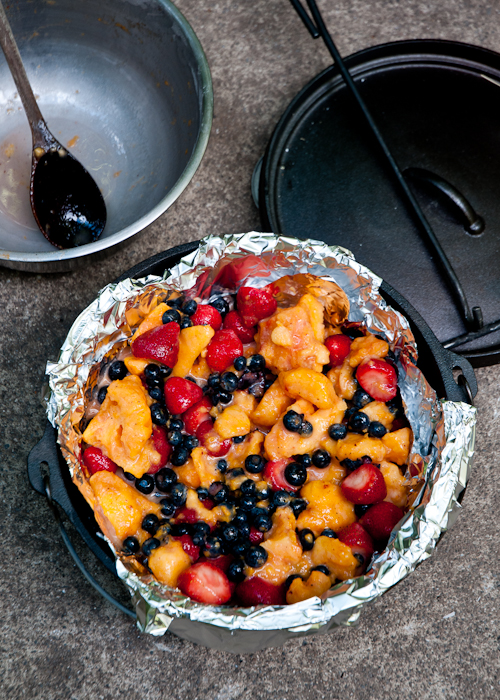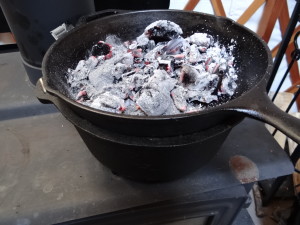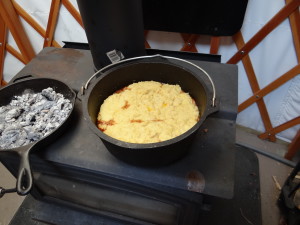I started camping with cast iron pans a few years ago, knowing only that cowboy cooks used cast iron pots on the range. I remembered photos of Dutch oven pots hanging from a tripod so that is where I began. From there, I tried cooking directly over coals or in a skillet on a grate. Most recently, I tried cooking with cast iron pots on a wood stove. None of these is the ideal method.
Cast iron Dutch Ovens simulate an actual oven, which provides all around heat without a pot/pan touching the cooking elements. To create a similar baking environment around a campfire you need a footed Dutch oven with a flat, rimmed lid:

The feet keep the oven above the heating element (coals), and the lid holds the upper coals that provide the top element for baking. In fact, to cook this way, you do not even need to put the Dutch Oven in the fire. Simply place hot coals in a shallow circle so they do not touch the pan bottom, place the Dutch oven over the circle, add more coals to the lid. Some people even use glowing charcoal briquets instead of campfire coals as seen below:

My Dutch Oven cookbook even tells me how many hot coals to use on the bottom and top, depending on what I am cooking. Many times I have pulled into a campsite, started charcoal in a small pile, set up the camper, then returned to the coals and made dinner. This method is the best for baking, baking/food combos (beans and cornbread), and cooking a roast. I also roast sweet potatoes using the oven method.

The tripod cooking method is best for liquids, like soup, unless you lower the pot close to dying embers and place coals on top, like above, to create an oven. Below is for cooking stew or simmering over direct heat.
In either case (oven or direct heat) you can use foil to prevent sticking/burning.

Cast iron skillets and griddles are used with direct heat, although the fire should be burned down a bit or the pan elevated on a grill. This is how to fry on a cast iron pan or griddle


The skillet makes a great lid for a cast iron pot as well. My footed Dutch oven did not work well on a wood stove. The pot was too far above the stove surface to create the oven effect I wanted. So, I put the skillet on top of the pot and put coals from the wood stove in the skillet. The result: great cornbread!

Skillet on top of Dutch Oven. Hot coals in the skillet created the oven effect.
The trick to using cast iron cookware for years is in the pan seasoning. You can find lots of instructions online how to season and then clean them. Don’t believe the label on a new pan if it says “pre-seasoned”. Season it anyway.
After cleaning without soap, I dry my cast iron on the burner or campfire, then rub them with olive oil. Occasionally I bake them all in a 300-degree oven for half a day, after oiling them first. When I had the wood stove in the yurt, I left my clean cast iron pans sitting on the hot stove when I was not cooking, to season them even more.
I also use cast iron at home. I have two home skillets and a biscuit pan. The skillet is great on the stove top, but also a fabulous baking pan. I use it for rolls, bread, omelets, etc etc etc.
Biscuit pan




A fried egg in cast iron is fabulous!!!! On the lookout for a larger skillet!
Yum…haven’t tried that yet. Maybe some fried potatoes and onions too? Feta cheese?